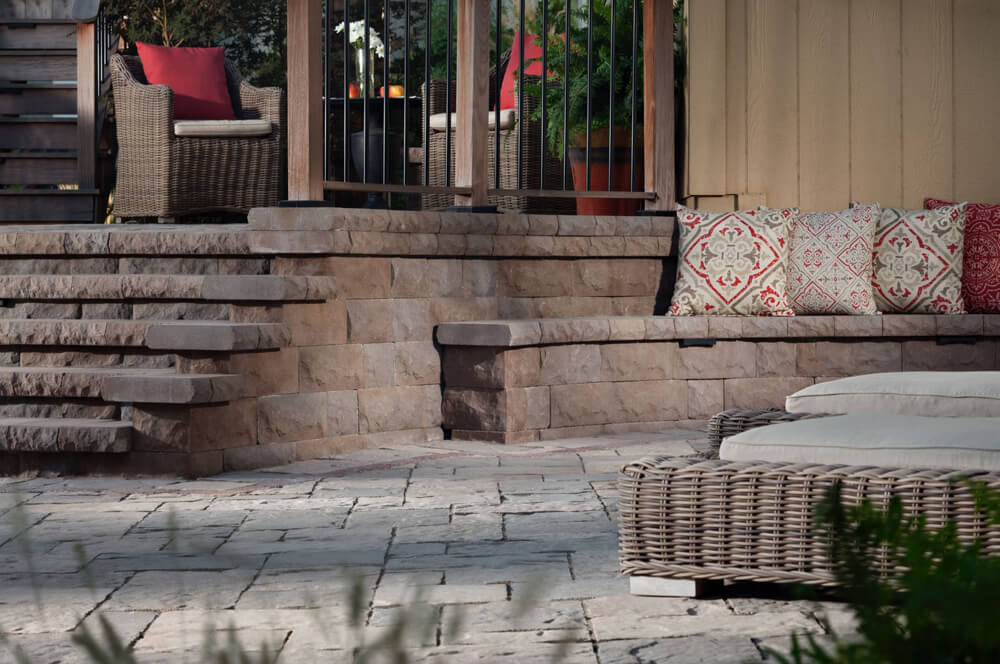How to Build a Sitting Wall from Pavers

Imagine a calm walk through a green, luscious English countryside, the air fresh and still, and your steps taking you to a beautiful stone wall garden. Deep green ivy envelopes the weathered stone walls, and a grassy path guides you through a well-hidden alcove where you come across a beautiful, built-in stone bench.
This style of inviting outdoor space is making a comeback in modern gardens as people begin to spend more time outside. If you love the idea of a sitting wall in your yard, you can build one yourself, and here’s how.
Choosing a Paver Seating Wall Design
The beauty of paver sitting walls lies in their versatility. Here are three designs that you can consider:
- Curved sitting wall around a fire pit.
This style eliminates the need for outdoor furniture, preserves the warmth from the fire, and makes it easy to have guests over for those starry evenings next to the fire. - Sitting wall built against a retainer wall.
This style of seating wall creates a backrest and is perfect in terraced gardens. - Bordering sitting walls.
This style of sitting wall delimits your yard space and offer an open view over the rest of the garden or landscape. It is perfect for homes surrounded by nature, like lakeside residencies.
Cost Comparison
The cost of your project will depend on the materials you use, the size of the wall, and any extra elements you want to add. Typically, you can expect to pay around $20 per foot for a simple, single-layered wall.
Plan Out and Mark Your Wall
A sitting wall can serve many functions, including delimiting an area and doubling as a retaining wall. Its position, length, and shape are crucial for the overall look of your yard, so take your time to mark it properly. You can use wooden stakes and string or marking paint to mark the shape of the wall.
Dig Deep – Prep Your Ground Before You Build
Start by digging a trench to ensure your sitting wall has a solid base. Half of the first course must be buried, which means your trench will be about 6 to 8 inches deep. Make sure to leave at least 1 inch on each side of the blocks.
Some basic tools you will need for building your sitting wall include:
- Spade
- Hand tamper
- Mason line and level
- Rubber mallet
- Mason’s chisels
- Caulk gun
Laying the Foundation
The next step is to lay a paver base. A paver base is a mix that helps to build a solid layer for your wall pavers. It’s crucial to properly level and compact the base, as it gives the setting bed strength and stability.
Paver for the Course
After levelling the base, lay the first layer of pavers. Check the alignment of the first course with a 4-foot level, as the entire structure depends on it. Next, backfill the side gaps with stone dust, and continue laying pavers. Use masonry glue to cement the layers together. The last layer typically consists of capstones. They can be smoother and different from the rest for a neat look.
If you’re looking for construction materials for your sitting wall project, Fulton Brickyard is here to help. We’ve got a wide range of bricks, pavers, sleepers and much more. Get in touch with us today for a free quote!
Image Source: Belgard
- Are Sandstone Paver Walkways Safe for Pets and Children?
- Artificial Turf vs Natural Grass: Which is Better for Your Yard?
- Can You Pressure Wash a Wooden Deck?
- The Benefits of Permeable Pavers in Stormwater Management
- The Importance of Proper Drainage Planning for Your Backyard or Garden
- Common Mistakes to Avoid When Cleaning Sandstone Pavers
- How to Repair Broken or Sunken Pavers
To learn more about the outstanding benefits of our expressive, evocative,
and natural granite pavers call us today on:
